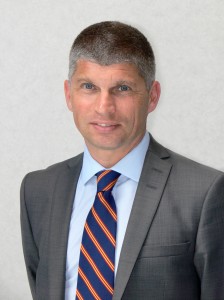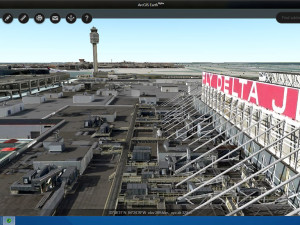Through its Geo-Intelligence programme line, Airbus Defence and Space (formerly the GEO-Information division of Astrium Services) has been significantly increasing its Earth observation capacity for some time, including a diverse array of sensors at different resolutions, as well as commercial radar imagery that can capture data at night and through clouds. Sensors & Systems (S&S) editor Matt Ball recently spoke with Bernhard Brenner, executive director Geo-Intelligence programme line, about the company’s diverse data collection platforms and upcoming plans. The conversation ranged from satellite capacity, opportunities in the commercial market to deliver solutions and services, and the overall market prospects for their data and services.

Bernhard Brenner
Executive Director
Geo-Intelligence programme line
Airbus Defence and Space (formerly Astrium)
S&S I was fascinated by your work history at another Airbus Group (former EADS) company, having managed Eurocopter operations in both South America and Southeast Asia. Do the similarities between helicopters and Earth observation go beyond having a view of the Earth from above?
BRENNER Another parallel is that when you sell a person a helicopter, they’re not always interested in the helicopter. They are interested in the mission. I think the same thing is true of satellites. Many of our customers are not interested in satellites; they’re interested in the mission and the results coming from this data. I think it is important that we remain focused on what the customer wants to do with the images, and how we can deliver them. We want to be both market-oriented and mission-oriented.
S&S Airbus Defence and Space is investing heavily in the market, with so many satellites getting ready to launch, and so many already in orbit. You’re in an impressive position compared to the rest of the market, although there seems to be a great number of new competitors emerging lately.
BRENNER We are indeed completing our optical constellation with SPOT 7 soon on its way and our radar capacity with PAZ, the Hisdesat satellite, expected for 2014. This gives us high reactivity and faster access to any target every day. We also have a unique acquisition capacity both with Pléia
S&S On the very high resolution segment of the market, there’s such an international push now to remove the resolution restrictions. Do you think that may resolve to allow you to commercially sell the best quality imagery that you capture?
BRENNER There is more demand always for very high resolution, but you can get a very high resolution with airplanes and with drones. I think the market is pushing for very high resolution. Whatever is the demand, we of course obey the restrictions and laws fixed by governments with regards to security and sovereignty considerations.
S&S On the SPOT and Pléiades satellites you have a nice combination of resolution, including very high resolution. Is there any gap right now in terms of your optical capacity?
BRENNER Indeed, while SPOT 6 and SPOT 7 will provide a wide view over a large area, Pléiades 1A and Pléiades 1B will be able to offer, the same day and for the same zone, products with a narrower field of view, but with an increased level of detail. You can imagine how useful this capacity is for our customers whether they are in the defence, institutional or commercial sectors.
S&S Your radar offering has some nice advantages. What are some of the ways that you’re providing solutions with a combination of optical and radar imagery?
BRENNER TerraSAR-X and TanDEM-X are very successful so far. For example, we utilize radar and optical for forest mapping to discriminate difficult land classes. Also in cloudy equatorial areas, radar elevation models complement the optical elevation coverage. You might know that we are working on the WorldDEMTM project to be commercially available later this year. The complete coverage of the Earth will soon be finished. It has been completed twice, and will be done a third time—and even a fourth time—if necessary in order to meet our quality requirements. The multiple visits are particularly important for difficult terrain such as in mountainous regions. This is a product that is definitely unique, and that will establish a new standard for digital elevation modeling.
S&S You’re in a bit of a unique position at Airbus Defence and Space, as a different division of your company is building satellites, including the upcoming series of satellites for the EU’s Copernicus (formerly GMES) satellites. Is there some crossover between the two groups?
BRENNER We succeeded in the sale of some satellites (I’m sorry, but I can’t tell you which ones) because of our offering on the services side. Sometimes, the customer is more interested in the soft skills of how to operate and what to do with the satellite rather than the hardware. Sometimes to prepare the arrival of their own satellite the customer asks for some services immediately. This is the beauty of our group (Airbus Group), and within Airbus Defence and Space, that we can meet the customer with both strengths: hardware and how to operate the satellite. In many countries it is difficult working with the requirements of various departments that may not be satisfied with the output of data. Different departments and ministries have different objectives. The beauty of our group is our ability to handle both sides, and to tailor output to different needs. This is true for Copernicus as well. Our interest is much larger because we are building some of the satellites, and also can make use of the data. Airbus Defence and Space operates the optical and radar-based satellites—SPOT, Pléiades, TerraSAR-X and TanDEM-X—that supply data for Copernicus services. But we also play a major part in the construction of the Sentinel satellites that will complement the data from the Copernicus Contributing Missions.
S&S On the services and solutions side, I understand that you’ve added some cloud capacity to help deliver imagery.
BRENNER We will never focus only on data; we will always focus on solutions and services as well. One of the services is to stream data and offer cloud services to improve the delivery of data to the customer. We are technology and platform agnostic. In the end, we just want to enter new markets, and this can be reached through ArcGIS from Esri, from Google Earth and Google Map Engine, or through our own platforms like Get GEO and DataDoors. Our target is to take full advantage of all the platforms and routes to market.
S&S Your materials discuss being the fastest to the desktop. Is speed a growing advantage for satellite imagery?
BRENNER Speed is of the essence, definitely. The freshness and reactivity of the data is important, and this is the feedback we have been getting from Pléiades customers. For example, we added Google as a customer in September based largely on speed. I don’t know if we are the fastest—and of course accuracy is important—but we can deliver direct tasking of Pléiades imagery within one hour of the original request.GeoStore, our imagery portal on the Internet, facilitates ordering and also includes an option for instant tasking. This is a new innovation aimed at empowering the customer, because it allows our customers to task the satellite of their choice as it passes over their area of interest—essentially “having the joystick.”
S&S Were you impacted at all by the sequestration or U.S. government shutdown?
BRENNER Unfortunately, not really, at least not as much as some of our competitors. We’d like to be more impacted, because it would mean that we do a lot of business with the U.S. government. To take your question more generally, we are quite balanced in our market across the world between continents. One third of our business is with Asia, one third with North and South America, and one third in Europe and the Middle East. This balance is also achieved in terms of customer segments. We feel pressure on budgets in Europe too, but we are able to compensate and find other areas of growth. So far, we have done quite well, thanks in part to our distribution worldwide, with 34 receiving station partners and 140 resellers worldwide.
S&S What is the picture in terms of your balance of commercial and government clients and services? Are you focused on delivering vertical market solutions to any particular industries?
BRENNER We want to grow in commercial markets. We have defense, institutional and commercial markets. In the institutional market, we are quite strong. We have defense customers in many countries, but a potential to do better. Commercially, the oil and gas market is interesting notably because we have the unique combination of optical and radar imagery as well as value added services. We have a strategic agreement with Spatial Energy in Boulder, and we are working very well together.
S&S Are there other vertical markets that you’re poised to address? I know that DigitalGlobe has an international fishing product. Are there similar solutions that you foresee?
BRENNER We checked our portfolio, and the answer is in defense, oil and gas, maritime activities, and we also want to satisfy the internal needs of our huge group, formerly known as EADS, now called Airbus Group. In the last few years, we’ve done big solution deals with our aviation and space companies, where there is a huge internal demand for this kind of data. We won a big border control project with the former EADS Cassidian division, and our satellite data was a big part of that solution.
S&S You have a lot of products, and a good diversity across the globe. As a final topic, I’d like to touch on the promise of the overall market versus current market performance. There is an increasing level of competition, but is the competition cutting into profits or stirring more interest in the data and solutions overall?
BRENNER That’s an interesting question. You can imagine that I’m amazed every day by what I learn. Even people that have been in this industry for a very long time are quite amazed to see new kinds of customer requests. I think it’s just fascinating what you can do with the intelligence coming out of satellite data. In some markets, we match the expectation. In other areas, we are surprised to learn of new requirements and we try to meet them. That’s the beauty of this industry, which is quite dynamic. There are always new things popping up.




